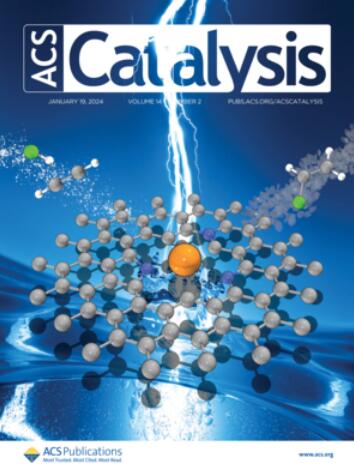Atomic Control of Surface Active Site Isolation in Pd2Sn Nanocatalysts via Crystal Phase to Enhance Hydrogenation Selectivity
IF 11.3
1区 化学
Q1 CHEMISTRY, PHYSICAL
引用次数: 0
Abstract
Crystal-phase modulation of nanocatalysts is an effective strategy for enhancing catalytic performance in heterogeneous catalysis by altering the surface electronic and geometric structures. However, accurately elucidating the relationship between chemical reactivity and surface atomic arrangement of nanocatalysts with distinct phases is a big challenge due to surface relaxation and reconstruction. Here, we achieved the phase transformation of Pd2Sn nanocatalysts from an orthorhombic to a hexagonal crystal structure by meticulously adjusting the thermal treatment conditions, thereby enhancing the selectivity of ethylene in the acetylene hydrogenation reaction to 93.7%, superior to most reported advanced catalysts. The atomic three-dimensional deciphering for the crystal phase effect of Pd2Sn nanocatalysts was revealed by a combination of atomic pair distribution function (PDF) and reverse Monte Carlo simulation (RMC). The results show that numerous Pd sites, characterized by a low Pd–Pd coordination number and highly isolated by Sn atoms, are present on the surface of Pd2Sn hexagonal phase nanocrystals. DFT calculations further verify that the unique local coordination structure of the Pd sites and the appropriate hybridization of the Pd 4d and Sn 5p orbitals on the surface of hexagonal phase Pd2Sn are crucial for attaining highly selective hydrogenation of acetylene.

晶体相对Pd2Sn纳米催化剂表面活性位点分离的原子控制以提高加氢选择性
纳米催化剂的晶相调制是通过改变其表面电子结构和几何结构来提高多相催化性能的一种有效方法。然而,由于表面弛豫和重构的原因,准确地阐明具有不同相的纳米催化剂的化学反应性与表面原子排列之间的关系是一个很大的挑战。本研究通过对热处理条件的精心调整,实现了Pd2Sn纳米催化剂由正交晶型向六方晶型的相变,从而使乙炔加氢反应中乙烯的选择性提高到93.7%,优于目前报道的大多数先进催化剂。采用原子对分布函数(PDF)和反向蒙特卡罗模拟(RMC)相结合的方法,揭示了Pd2Sn纳米催化剂晶体相效应的原子三维解析。结果表明,Pd2Sn六方相纳米晶体表面存在大量Pd位,其特征是Pd - Pd配位数低,且与Sn原子高度隔离。DFT计算进一步验证了Pd位独特的局部配位结构以及Pd - 4d轨道和Sn - 5p轨道在六方相Pd2Sn表面的适当杂化是实现乙炔高选择性加氢的关键。
本文章由计算机程序翻译,如有差异,请以英文原文为准。
求助全文
约1分钟内获得全文
求助全文
来源期刊

ACS Catalysis
CHEMISTRY, PHYSICAL-
CiteScore
20.80
自引率
6.20%
发文量
1253
审稿时长
1.5 months
期刊介绍:
ACS Catalysis is an esteemed journal that publishes original research in the fields of heterogeneous catalysis, molecular catalysis, and biocatalysis. It offers broad coverage across diverse areas such as life sciences, organometallics and synthesis, photochemistry and electrochemistry, drug discovery and synthesis, materials science, environmental protection, polymer discovery and synthesis, and energy and fuels.
The scope of the journal is to showcase innovative work in various aspects of catalysis. This includes new reactions and novel synthetic approaches utilizing known catalysts, the discovery or modification of new catalysts, elucidation of catalytic mechanisms through cutting-edge investigations, practical enhancements of existing processes, as well as conceptual advances in the field. Contributions to ACS Catalysis can encompass both experimental and theoretical research focused on catalytic molecules, macromolecules, and materials that exhibit catalytic turnover.
 求助内容:
求助内容: 应助结果提醒方式:
应助结果提醒方式:


